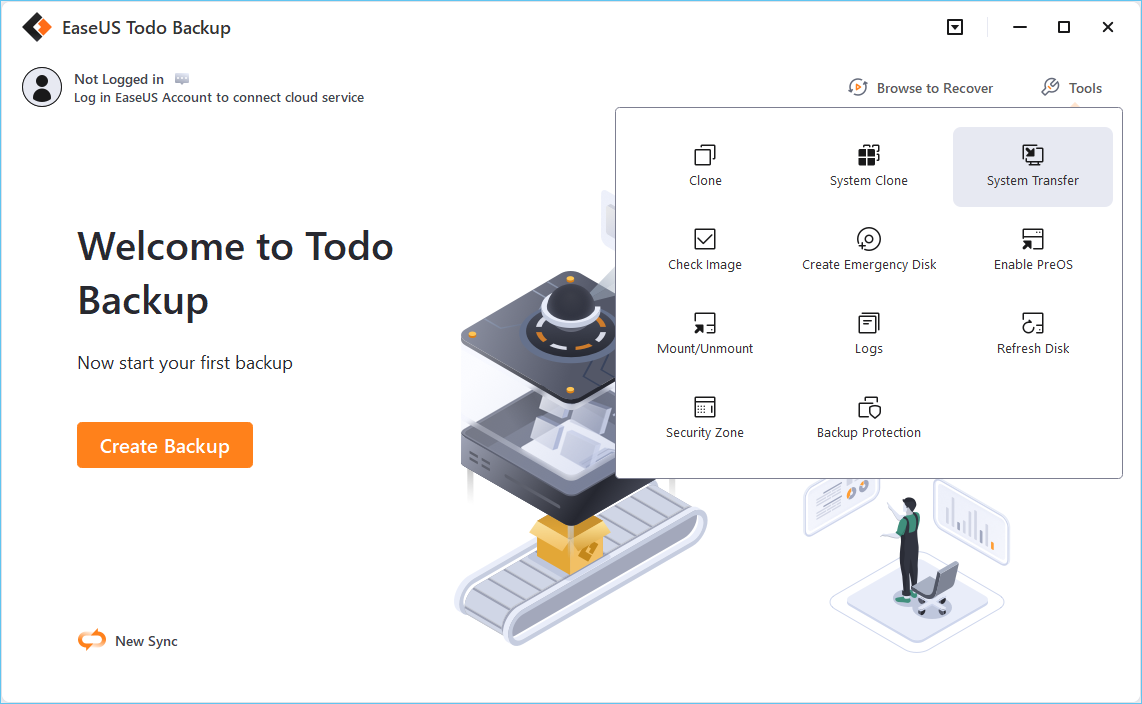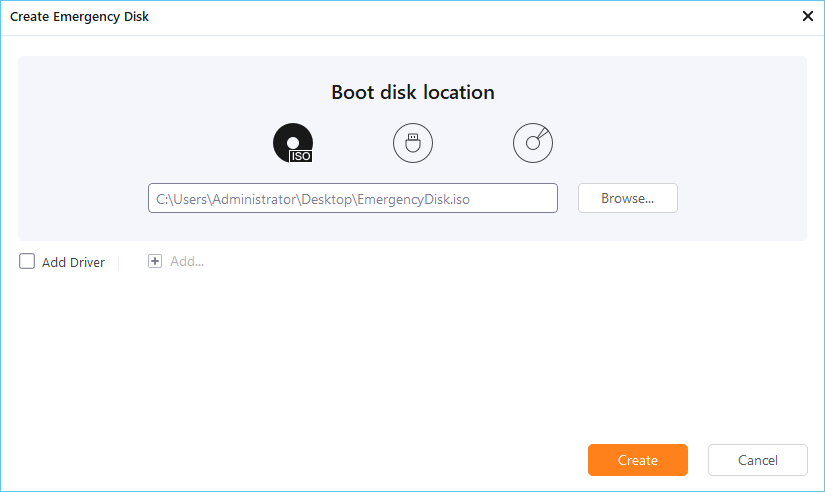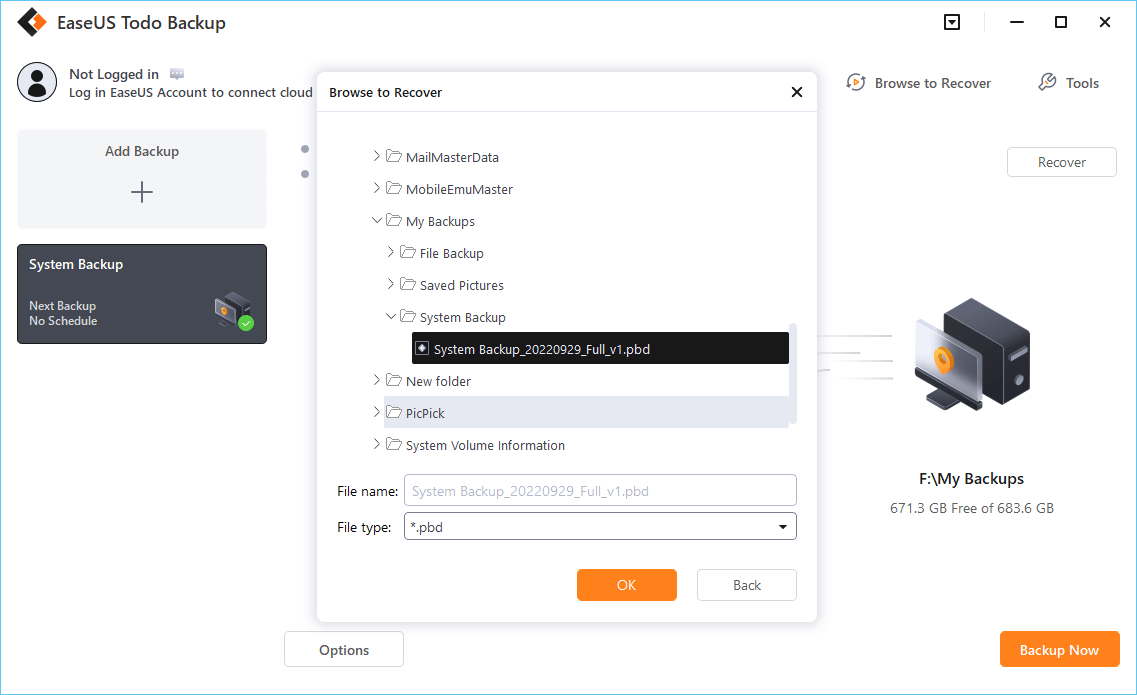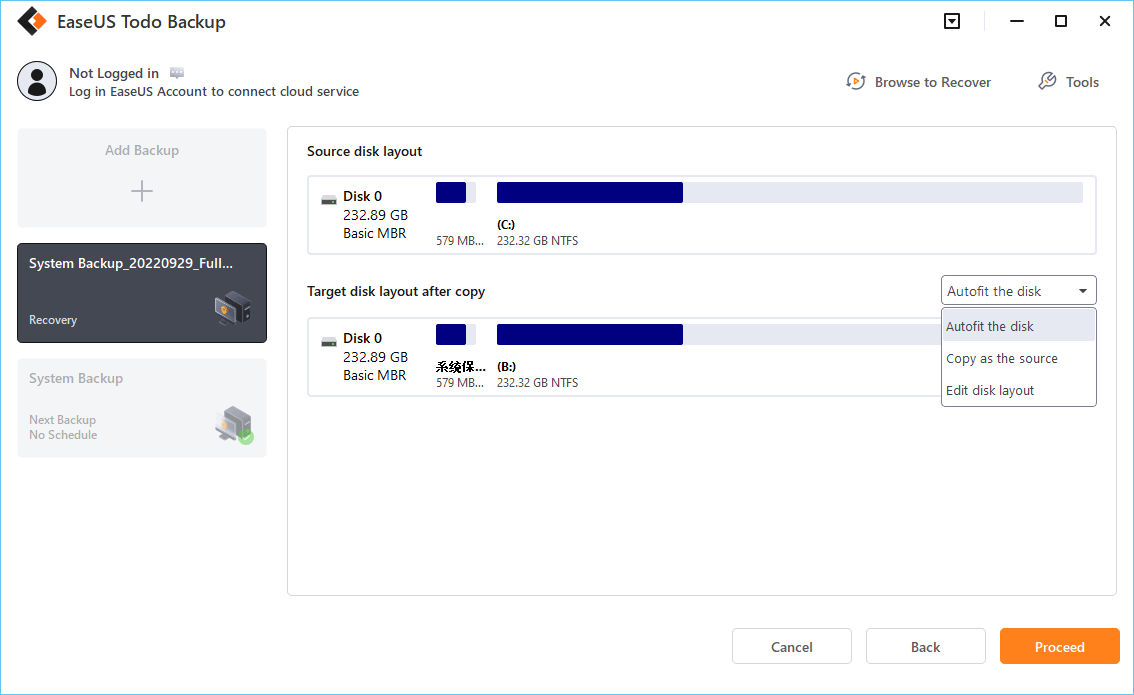Are you looking for a complete guide to backup Windows 10 and restore system image to different computers? On this page, you'll learn how to create a system image in Windows 10/8/7 and restore it to a new computer without reinstallation.
So how to do so? Follow the complete guide here for help:
| Content Navigation | Step-by-step Troubleshooting |
|---|---|
| Preparation: Get ready for System Transfer | Check new PC boot mode, backup Windows system...Full steps |
| How to Create and Restore System Image | Backup or Copy Important Data from Target PC...Full steps |
| Why not recommend Windows Backup and Restore | Compared with backup software, Windows Backup and Restore has limitations...Full steps |
Can a Windows System Image Be Used on Another Computer
Is there any effective way to restore a system image to another computer or transfer a system image to another drive just as easy as to restore a file image to a dissimilar computer? If a person is savvy about computers, he would definitely say "NO".
The reason is that the configuration settings on another computer may differ from your current PC. Also, the operating system requires the computer to include certain drivers, without which the computer won't boot successfully.
So can you create and restore a system image to a dissimilar computer? Yes! With the help of reliable Windows backup software, transferring OS to a new computer is possible.
Secure Download
Preparations: Get Ready for System Transfer to Different PC
You may want to know what exactly you'll need to get things ready for system migration to another different computer. Here below is a list for you to know and prepare for this task:
- #1. Confirm New PC Support The Same Boot Mode as Old PC
- #2. Download Windows Backup Software
- #3. Prepare an External Hard Drive
Note that the listed tips are three key points that decide whether you can successfully create and restore a system image to a new computer. Follow to make everything ready now:
#1. Confirm New PC Support The Same Boot Mode as Old PC
The motherboard of your new computer must support the same boot mode as your source computer. You can follow to check the boot modes on both of your PCs:
Restart PC and hold F2/F8/Del to Enter BIOS > Go to the Boot Menu and Check the Boot Mode: Legacy or UEFI.

In a word, the BIOS boot mode in the new computer should be the same as your current PC:
- BIOS Mode: Legacy - BIOS Mode: Legacy
- BIOS Mode: UEFI - BIOS Mode: UEFI
IMPORTANT: If your computer is too old and it doesn't support the UEFI boot mode, you'll need to switch to a new computer. Most new computers support both Legacy and UEFI boot modes and you don't need to worry about it.
#2. Download Windows Backup Software
Professional system backup software - EaseUS Todo Backup can help. Its System Transfer feature can do the system backup and transfer task, making the Windows system bootable on the new computer by transferring necessary drivers together.
Secure Download
#3. Prepare an External Hard Drive
It's also important that you have a big enough external hard drive to save the Windows system image for transferring OS to a new computer. Here are the steps that you can follow to prepare the external hard drive:
Step 1. Prepare an empty external hard drive with enough space.
The capacity of the external hard drive must be bigger than the system C drive.
Step 2. Open Disk Management and create two partitions on your external hard drive.
The first partition is FAT32 and the second partition is NTFS (bigger than your system drive).

After making all things ready, you are good to go and follow the tutorial below to start creating and restoring system image like Windows 10 to your new computer now.
Tutorial: How to Create and Restore System Image to a Different Computer
Applies to: Transfer Windows 10/8/7, even Windows XP/Vista, to a new computer without reinstallation.
This part answers the question of "How do I create system image in Windows 10" and "How to restore a Windows 10 backup to another computer". Follow the tutorial guide here to make your current Windows system bootable on a different computer:
- #1. Backup Data
- #2. Create and Restore (Windows 10) System Image to a New Computer
- #3. Make Transferred System Bootable on New Computer
In the following, we'll take Windows 10 as an example to show you the complete process of backing up and transferring the system to another computer. Let's start!
#1. Backup or Copy Important Data from Target PC to External Hard Drive
As the system transferring process will rewrite everything on the system C drive, which will certainly cause data loss.
Therefore, if you have important data saved on your target computer system drive, we suggest you copy and save them to an external storage device as a backup in advance.
#2. Create and Restore (Windows 10) System Image to a New Computer
Now, you can apply EaseUS Todo Backup to create a bootable disk, create a system image, and restore the system image to another computer without limits.
Tutorial: Create and Restore Windows System Image to a Different Computer
Step 1. Create an Emergency Disk to USB
1. Connect an empty USB flash drive or external hard drive (with over than 100GB space) to your PC.
Note: Initialize the USB or external hard drive as MBR, and create two partitions: set the first partition as FAT32 and the second partition as NTFS.
2. Run EaseUS Todo Backup and click "Tools" > "Create Emergency Disk".
3. Choose USB as the disk location to create the emergency disk and click "Create".
The bootable disk will help you boot computer and transfer system image to the new PC.
Step 2. Create System Backup Image on Source Computer
1. Click "OS" on the main page and Windows OS will be selected by default.
2. Choose the second partition of the USB drive which contains the emergency disk to save system image.
You may also save system backup image to another empty external disk (which must be equal or bigger than the system C drive).
3. Click "Backup Now" to start creating a system backup image to the target device.
Step 3. Boot Target Computer from EaseUS Todo Backup Emergency Disk
1. Eject EaseUS emergency disk and system backup image USB and connect it to the new computer.
2. Restart PC and press "DEL/F2/F10/F12" to boot into BIOS.
3. Go to the boot menu and set the computer to boot from the EaseUS Todo Backup emergency disk.
If you want to restore the system image to a GPT disk, you need to change the boot mode to EUFI in BIOS. Then your computer will enter EaseUS Todo Backup main interface.
Step 4. Transfer System to the New Computer
Note: Restoring system image to the new computer will erase the data on the target disk. Remember to back up the files in advance or use an empty disk to restore the system image to avoid data loss.
1. On EaseUS Todo Backup main interface, click "Tools" > "System Transfer".
2. Select the system image on your USB external drive and click "OK" to continue.
3. Then click "Proceed" to start transferring the system to a new computer.
Step 5. Restart PC with transferred system
1. Enter BIOS and set computer to boot up from the drive with the transferred system.
2. Save all changes and restart your computer.
3. Update all drive drivers and programs to ensure all things will work just fine on the new computer.
#3. Make Transferred System Bootable on New Computer
When EaseUS Todo Backup completes the system transferring process, you have one last step to go. It is to configure the BIOS boot mode on your computer as the same as your old PC:
Step 1. Restart PC and press F2/F8/Del to enter BIOS.
Step 2. Go to the Boot menu and find BIOS Mode.
Step 3. Switch the boot mode as the same as it was on your old PC - Legacy or UEFI.
Step 4. Save the changes and exit to boot your computer.
Wait patiently and you'll see that your computer will boot up smoothly with the same operating system on your old PC.
- For Your Information
- EaseUS Todo Backup only transfer your OS. To activate Windows, you'll need a new activation key.
Further Reading: Why Is Windows Backup and Restore Not Recommended
According to some Windows professionals, they prefer to create system image via Windows Backup and Restore feature. But why is Windows Backup and Restore not recommended here?
Windows Backup and Restore vs. EaseUS Todo Backup
Here is a comparison table that you may interested in and you will figure out why EaseUS Todo Backup exceeds Windows Backup and Restore:
| Comparison | EaseUS Todo Backup | Windows Backup and Restore |
|---|---|---|
| File Backup | √ | √ |
| System Backup | √ | √ |
|
System Transfer (To a New Computer) |
√ | × |
Due to the limit of Windows Backup and Restore, Windows 10/8/7 users can only use it to backup and restore the system or files on the current PC. It doesn't work to back up and transfer the system to a new computer.
If you want to create a Windows image via Windows Backup and Restore, refer to Backup Windows 10 to USB for help.
If you are a Windows beginner and prefer a feasible solution to backup Windows and transfer system, EaseUS Todo Backup can be your best shot.
The Bottom Line
This page answers the questions of all Windows users about "How to use Windows image on a different computer" or "How to create and restore system image to a new computer".
To do so, you'll need a reliable Windows backup software like EaseUS Todo Backup to create a Windows system image first. Then save the system image to an external hard drive.
Secure Download
Last, you'll need to restore the system image to your new computer and set the computer bootable by configuring the BIOS mode.
FAQs on Restore Windows Image to A Different Computer
Can I restore Windows 10 to another computer?
Yes, of course. You need to back up the old Windows 10 system first and then restore the backup to the new computer. Follow the steps in the post to restore it.
How do I restore the Windows image?
If you use the Windows Backup tool to backup, then you can restore the Windows image to a new PC with the following steps: Open settings - System - Backup, and then select the "Restore from a system image" option. Click "Select recovery disk" and choose the Windows backup drive. Choose "Only restore system drives," click "Next," and then follow the wizard to finish the process.
Was This Page Helpful?
Updated by Jerry
"I hope my articles can help solve your technical problems. If you are interested in other articles, you can check the articles at the bottom of this page, and you can also check my Facebook to get additional help."
Jean is recognized as one of the most professional writers in EaseUS. She has kept improving her writing skills over the past 10 years and helped millions of her readers solve their tech problems on PC, Mac, and iOS devices.
Related Articles
-
Clear & Easy | How to Make A CD Bootable (Also Works with DVD)
![author icon]() Jean/Jun 18, 2024
Jean/Jun 18, 2024 -
How to Ghost Hard Drive in Windows 10
![author icon]() Tracy King/Jul 08, 2024
Tracy King/Jul 08, 2024 -
[Beginner's Guide] Migrate OS from SSD to M.2 SSD with M.2 SSD Clone Software
![author icon]() Jean/Nov 25, 2024
Jean/Nov 25, 2024 -
How to Auto Sync Files to External Hard Drive on Windows
![author icon]() Larissa/Mar 20, 2024
Larissa/Mar 20, 2024




